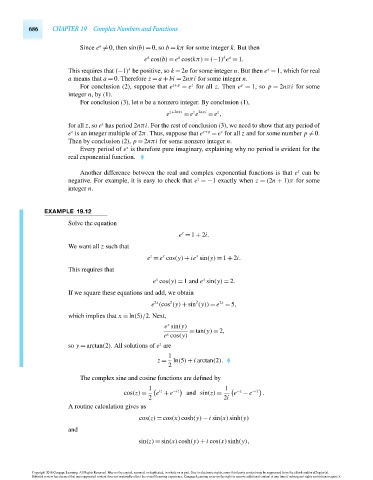Page 706 - Advanced_Engineering_Mathematics o'neil
P. 706
686 CHAPTER 19 Complex Numbers and Functions
a
Since e = 0, then sin(b) = 0, so b = kπ for some integer k. But then
a
k a
a
e cos(b) = e cos(kπ) = (−1) e = 1.
a
k
This requires that (−1) be positive, so k =2n for some integer n. But then e =1, which for real
a means that a = 0. Therefore z = a + bi = 2nπi for some integer n.
z
p
For conclusion (2), suppose that e z+p = e for all z. Then e = 1, so p = 2nπi for some
integer n,by(1).
For conclusion (3), let n be a nonzero integer. By conclusion (1),
z
z 2nπi
e z+2nπi = e e = e ,
z
for all z,so e has period 2nπi. For the rest of conclusion (3), we need to show that any period of
z
z
e is an integer multiple of 2π. Thus, suppose that e z+p = e for all z and for some number p = 0.
Then by conclusion (2), p = 2nπi for some nonzero integer n.
z
Every period of e is therefore pure imaginary, explaining why no period is evident for the
real exponential function.
z
Another difference between the real and complex exponential functions is that e can be
z
negative. For example, it is easy to check that e =−1 exactly when z = (2n + 1)π for some
integer n.
EXAMPLE 19.12
Solve the equation
z
e = 1 + 2i.
We want all z such that
z
x
x
e = e cos(y) + ie sin(y) = 1 + 2i.
This requires that
x
x
e cos(y) = 1 and e sin(y) = 2.
If we square these equations and add, we obtain
2
2x
2x
2
e (cos (y) + sin (y)) = e = 5,
which implies that x = ln(5)/2. Next,
x
e sin(y)
= tan(y) = 2,
x
e cos(y)
z
so y = arctan(2). All solutions of e are
1
z = ln(5) + i arctan(2).
2
The complex sine and cosine functions are defined by
1 iz −iz 1 −z −iz
cos(z) = e + e and sin(z) = e − e .
2 2i
A routine calculation gives us
cos(z) = cos(x)cosh(y) − i sin(x)sinh(y)
and
sin(z) = sin(x)cosh(y) + i cos(x)sinh(y),
Copyright 2010 Cengage Learning. All Rights Reserved. May not be copied, scanned, or duplicated, in whole or in part. Due to electronic rights, some third party content may be suppressed from the eBook and/or eChapter(s).
Editorial review has deemed that any suppressed content does not materially affect the overall learning experience. Cengage Learning reserves the right to remove additional content at any time if subsequent rights restrictions require it.
October 15, 2010 18:5 THM/NEIL Page-686 27410_19_ch19_p667-694

